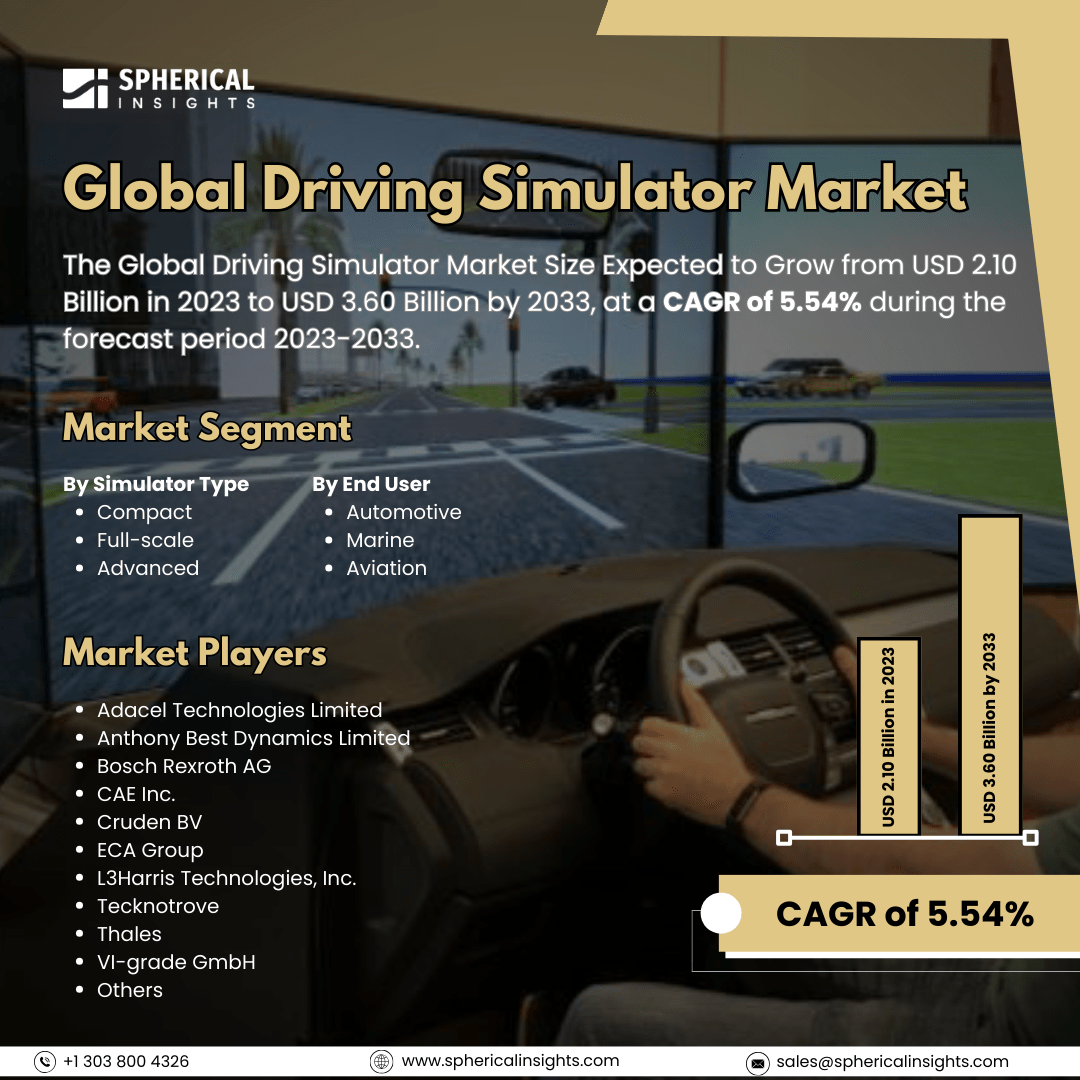Global Driving Simulator Market Size to Exceed USD 3.60 Billion by 2033
According to a research report published by Spherical Insights & Consulting, The Global Driving Simulator Market Size Expected to Grow from USD 2.10 Billion in 2023 to USD 3.60 Billion by 2033, at a CAGR of 5.54% during the forecast period 2023-2033.
Browse 210 market data Tables and 45 Figures spread through 190 Pages and in-depth TOC on the Global Driving Simulator Market Size, Share, and COVID-19 Impact Analysis, By Simulator Type (Compact, Full-scale, Advanced), By End User (Automotive, Marine, Aviation), and By Region (North America, Europe, Asia Pacific, Latin America, Middle East, and Africa), Analysis and Forecast 2023 – 2033
The driving simulator market refers to the industry of developing and deploying simulation systems that simulate real-world driving experiences for training, research, and entertainment reasons. These simulators utilize advanced hardware and software that provide realistic environments in driving applications; the primary thrusts are in driver training, automotive testing, road safety research, and gaming. Moreover, the increasing demand for safe and cost-effective driver training solutions in the automotive and transportation sectors drives the driving simulator market. Virtual reality and artificial intelligence improve simulation realism, thereby making training more efficient. Autonomous vehicle testing also increases the demand for high-fidelity simulators. In addition, the increasing road safety concerns and regulatory mandates to educate drivers have fuelled the market growth. Expansion of their applications in research, military, and motorsport training contributes also to the proliferation of driving simulators. However, restraints in the driving simulator market involve high initial costs, significant technological complexities, and constant software and hardware upgrade requirements. Limited access is also a restraint in the emerging markets as well as non-replication of real-world road conditions.
The full-scale segment accounted for the largest share of the global driving simulator market in 2023 and is anticipated to grow at a significant CAGR during the forecast period.
On the basis of simulator type, the global driving simulator market is divided into compact, full-scale, and advanced. Among these, the full-scale segment accounted for the largest share of the global driving simulator market in 2023 and is anticipated to grow at a significant CAGR during the forecast period. These simulators have highly immersive and realistic driving experiences, making them ideal for professional driver training, automotive testing, and research. Their extensive use in defence, aviation, and autonomous vehicle development drives market dominance.
The automotive segment accounted for a significant share of the global driving simulator market in 2023 and is anticipated to grow at a rapid pace during the projected period.
On the basis of the end use, the global driving simulator market is divided into automotive, marine, and aviation. Among these, the automotive segment accounted for a significant share of the global driving simulator market in 2023 and is anticipated to grow at a rapid pace during the projected period. There is increasing demand for testing autonomous vehicles, driver training programs, and research into vehicle safety, among others. Moreover, improvement in VR and AI-based simulation technologies will fuel further adoption for the development of electric and self-driving cars.
Europe is projected to hold the largest share of the global driving simulator market over the forecast period.
Europe is projected to hold the largest share of the global driving simulator market over the forecast period. The demand is driven by the region's strong automotive industry, extensive research in autonomous vehicle technology, and stringent road safety regulations. Moreover, leading automakers and simulation technology providers, especially in Germany and France, are contributing to the widespread adoption of driving simulators for training and testing.
Asia Pacific is expected to grow at the fastest CAGR growth of the global driving simulator market during the forecast period. Rapid urbanization, increased production of vehicles, and the rise in demand for driver training programs in countries like China, India, and Japan are driving market growth. Moreover, investments in the development of autonomous vehicles and technology advancements in simulation are further driving adoption across the region.
Company Profiling
Major vendors in the global driving simulator market are Adacel Technologies Limited, Anthony Best Dynamics Limited, Bosch Rexroth AG, CAE Inc., Cruden BV, ECA Group, L3Harris Technologies, Inc., Tecknotrove, Thales, VI-grade GmbH, and Others.
Key Target Audience
- Market Players
- Investors
- End-users
- Government Authorities
- Consulting and Research Firm
- Venture capitalists
- Value-Added Resellers (VARs)
Recent Development
- In September 2024, AB Dynamics and Ansible Motion announced the merging of their Driver-in-the-Loop (DIL) vehicle simulation businesses into a single, experienced driving simulator provider. The combination benefits from increased resources and expertise, with people from AB Dynamics, who have extensive experience, now at Ansible Motion.
Market Segment
This study forecasts revenue at global, regional, and country levels from 2023 to 2033. Spherical Insights has segmented the global driving simulator market based on the below-mentioned segments:
Global Driving Simulator Market, By Simulator Type
- Compact
- Full-scale
- Advanced
Global Driving Simulator Market, By End User
- Automotive
- Marine
- Aviation
Global Driving Simulator Market, By Regional
- North America
- Europe
- Germany
- UK
- France
- Italy
- Spain
- Russia
- Rest of Europe
- Asia Pacific
- China
- Japan
- India
- South Korea
- Australia
- Rest of Asia Pacific
- South America
- Brazil
- Argentina
- Rest of South America
- Middle East & Africa
- UAE
- Saudi Arabia
- Qatar
- South Africa
- Rest of the Middle East & Africa



